|
| December 2006 |
Fish Harvesting Employment |
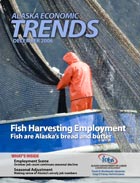 |
Fisheries play an economic role in Alaska similar to that of wheat farming in North Dakota or corn production in Iowa. The latest National Marine Fisheries Service release reported that over 55 percent of the total U.S. fisheries harvest by volume was taken in Alaska waters. That production translated into nearly one-third of the total U.S. harvest by value. Dutch Harbor/ Unalaska ranked first among U.S. ports interms of volume, more than doubling runner-up Reedville, Va. These are impressive numbers for a state whose population amounts to only two tenths of one percent of the nation’s total.
December 2006 Trends |
| |
|
| November 2006 |
Industry and Occupational Forecasts, 2004-2014 |
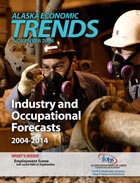 |
By 2014, the number of jobs in Alaska is expected to grow by more than 48,000, bringing the state’s total to more than 349,000 wage and salary jobs. Overall employment growth is expected to be 1.5 percent per year through the forecast period, driven especially by population growth and the increased availability of in-state goods and services – including medical. Although the total number of jobs is expected to grow by 16 percent from 2004 to 2014, not every industry will grow at that rate.
November 2006 Trends |
| |
|
| October 2006 |
Local Government |
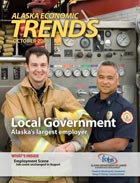 |
In Alaska, more than 40,000 jobs are generated by local government, making it the state’s single largest “industry employer.” Alaska has 146 incorporated cities, 16 boroughs, 229 federally recognized tribal governments, one Indian reservation and 53 school districts. What they do affects almost all Alaskans in some way. They provide a whole spectrum of services, ranging from K-12 education, public safety, health care and social services to city planning, utilities and road maintenance.
October 2006 Trends |
| |
|
| September 2006 |
Construction Costs and Building Activity |
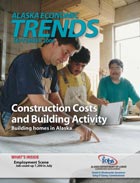 |
Boosted by record-low interest rates, Alaska and the rest of the nation have experienced a feverish housing market in recent years. Alaskans built some 4,700 homes a year from 2003 to 2005 (see Exhibit 1), making construction one of the fastest growing industries in Alaska.
September 2006 Trends |
| |
|
| August 2006 |
The Trends 100 |
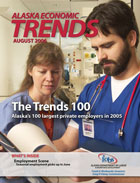 |
The Providence Health System has now topped the list of Alaska’s 100 largest employers for five years. No other companies are close to the 3,6851 employees Providence had in 2005 and it won’t be a surprise when the health care company hits the 4,000 mark. Providence’s work force had already reached 3,921 as of March 2006. Growth just keeps coming as the health care company adds new facilities to its main Anchorage campus and continues to expand geographically. Now Providence runs facilities in Kodiak, Seward, Valdez and in the Mat-Su area.
August 2006 Trends |
| |
|
| July 2006 |
The Cost of Living in Alaska |
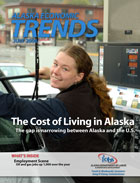 |
The high cost of living in Alaska is part of the state’s folklore. Stories are told of eggs being sold for a dollar each in Skagway during the Klondike gold rush and of converted garages renting for $1,000 a month in Fairbanks during construction of the trans-Alaska oil pipeline. Even during more stable economic periods, the unique benefi ts of living in the 49th state – a rugged and expansive land more remote from the nation’s population centers than every other state except Hawaii – come with unique costs.
July 2006 Trends |
| |
|
| June 2006 |
The Military is Big Business in Anchorage |
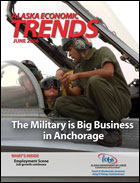 |
On June 27, 1940, about 18 months before Pearl Harbor was attacked and the United States entered World War II, the first military troops arrived in Anchorage, marking the beginning of a dramatic economic expansion that would last nearly two decades. In the words of Alaska historian Terrence Cole, “Anchorage was a war boom town which never seemed to stop booming.” By most accounts, the war put the Alaska Territory on the map and was the most important event in Alaska’s history since the gold rush.
June 2006 Trends |
| |
|
| May 2006 |
Employment Forecast |
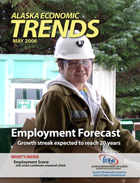 |
For 18 consecutive years Alaska has added jobs to its economy and two more years of growth are forecast in 2006 and 2007. In the short term, high oil prices, a generally favorable national and international economy, and significant federal spending in Alaska practically assure continued job growth over the forecast period.
May 2006 Trends |
| |
|
| April 2006 |
The Year 2005 in Review |
 |
Make it 18 in 2005. That’s 18 consecutive years of job growth, a record that only a handful of states can match and the longest stretch of growth since Alaska gained statehood. The last time the state lost jobs Ronald Reagan was president, Steve Cowper was governor, The Last Emperor won the Academy Award for best M picture, and Walk Like an Egyptian topped pop music charts. The year was 1987 and the state was in the second year of a deep recession caused by a collapse in the real estate market and a plunge in oil prices from over $30 a barrel to less than $10.
April 2006 Trends |
| |
|
| March 2006 |
A Young Work Force Grows Up |
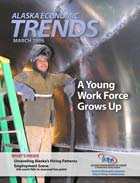 |
The early years of a person’s “working life” can be equal parts confusion and frustration. How does a young person gain meaningful work experience if he or she can never get hired for a skilled position, even an entry-level one?
March 2006 Trends |
| |
|
| February 2006 |
Employment in the Alaska Fisheries |
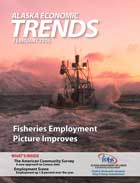 |
Since the late 1980s, much of the news about Alaska’s fisheries has been negative. Gross earnings fell 63 percent from 1988 to 2002 and the number of active permit holders fell 35 percent over the same period. The good news is that fi sheries data from 2003 and 2004 – including the employment estimates that are the subject of this article – suggest that the tide may have changed.
February 2006 Trends |
| |
|
| January 2006 |
Workplace Fatalities
in Alaska |
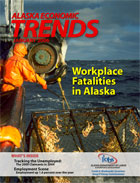 |
Alaska had 40 workplace fatalities – injuries
that resulted in deaths – in 2004. That is the second-lowest
number of workplace fatalities in the state since the fatality
census began in 1992. Between 1992 and 2004,1 721 workers died
in Alaska’s workplaces, an average of about one every seven
days.
January 2006 Trends |















